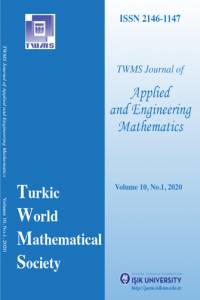ANALYSIS OF DISCRETE-TIME QUEUE WITH TWO HETEROGENEOUS SERVERS SUBJECT TO CATASTROPHES
This paper studies a discrete-time queueing system with two heterogeneous servers subject to catastrophes. We obtain explicit expressions for the steady-state probabilities at arbitrary epoch using displacement operator method. The waiting time distribution and outside observer’s observation epoch probabilities are deduced. Various performance measures and numerical results have been investigated
Keywords:
Discrete-time, catastrophe, multi-server, heterogeneous servers, waiting queue,
___
- Chao, X., (1995), A queueing network model with catastrophes and product form solution, Oper. Res. Lett., 18 (2), 75–79.
- Chen, A. and Renshaw, E., (1997), The M/M/1 queue with mass exodus and mass arrivals when empty, J. Appl. Probab., 34 (1), 192–207.
- Di Crescenzo, A. Giorno, V. Nobile A. G. and Ricciardi, L. M., (2003), On the M/M/1 queue with catastrophes and its continuous approximation, Queueing Syst., 43 (4), 329–347.
- Boudali, O. and Economou, A., (2012), Optimal and equilibrium balking strategies in the single server Markovian queue with catastrophes, Eur. J. Oper. Res., 218 (3), 708–715.
- Krishna Kumar, B. and Arivudainambi, D., (2000), Transient solution of an M/M/1 queue with catastrophes, Comput. Math. Appl., 40(10-11), pp.1233–1240.
- Krishna Kumar, B. and Pavai Madheswari, S., (2002), Transient behaviour of the M/M/2 queue with catastrophes, STATISTICA, 62 (1), 129–136.
- Krishna Kumar, B., Krishnamoorthy, A., Pavai Madheswari, S. and Sadiq Basha S., (2007a)
- Transient analysis of a single server queue with catastrophes, failures and repairs, Queueing Syst., (3-4), 133–141. Guo, P. and Hassin, R., (2012), Strategic behavior and social optimization in Markovian vacation queues: The case of heterogeneous customers, Eur. J. Oper. Res., 222 (2), 278–286.
- Larsen, R. L. and Agrawala, A. K., (1983), Control of a heterogeneous two-server exponential queueing system, IEEE Trans. Software Eng., 9(4), 522–526.
- Lin, W. and Kumar, P. R., (1984), Optimal control of a queueing system with two heterogeneous servers, IEEE Trans. Autom. Control., 29(8), 696–703.
- Krishna Kumar, B., Madheswari, S. P. and Venkatakrishnan, K. S., (2007b), Transient Solution of an M/M/2 Queue with Heterogeneous Servers Subject to Catastrophes, Int. J. Infor. Manage. Sci., 18 (1), 63–80.
- Hunter, J. J., (1983), Mathematical Techniques of Applied Probability, Vol. II, Discrete-Time
- Models: Techniques and Applications, Academic Press, New York. Gravey, A. and H´ebuterne, G., (1992), Simultaneity in discrete time single server queues with
- Bernoulli inputs, Perf. Eval., 14(2), 123–131. Bruneel, H. and Kim, B. G., (1993), Discrete-Time Models for Communication Systems Including
- ATM, Kluwer Academic Publishers, Boston. Takagi, H., (1993), Queueing Analysis – A Foundation of Performance Evaluation : Volume 3
- Discrete-Time Systems, North Holland, Amsterdam. Woodward, M. E., (1994), Communication and Computer Networks: Modelling with Discrete
- Time Queues, Los Alamitos, CA: IEEE Computer Society Press. Atencia, I. and Moreno, P. A., (2004), The discrete-time Geo/Geo/1 queue with negative customers and disasters, Comput. Oper. Res., 31(9), 1537–1548.
- Goswami, V. and Gupta, U. C., (1998), Analyzing the Discrete-time Multiserver Queue
- Geom/Geom/m Queue with Late and Early Arrivals, Int. J. Infor. Manage. Sci., 9 (2), 55–66. Artalejo, J. R. and Hern´andez-Lerma, O., (2003), Performance analysis and optimal control of the Geo/Geo/c queue, Perf. Eval., 52(1), 15–39.
- Goswami, V. and Samanta, S. K., (2009), Discrete-time bulk-service queue with two heterogeneous servers, Comp. Indus. Engg., 56 (4), 1348-1356.
- ISSN: 2146-1147
- Başlangıç: 2010
- Yayıncı: Turkic World Mathematical Society
